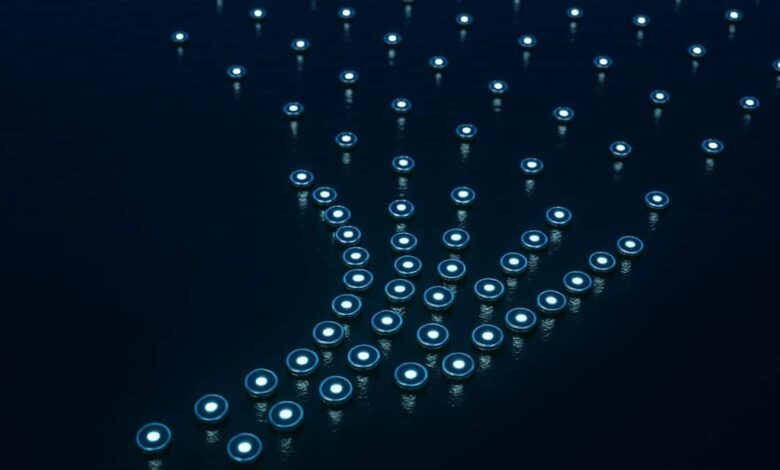Adaptive Robot Swarms The Future of Intelligent Materials

▼ Summary
– Researchers developed swarms of mini-robots that collectively transform, creating adaptive smart materials.
– The hockey-puck-shaped robots can alter properties like rigidity or fluidity, enabling self-repair and reinforcement.
– Each robot uses motorized gears, sensors, and magnets to navigate and switch between flexible and rigid states.
– Inspired by embryonic tissue, the robots mimic biological behaviors like remodeling through coordinated movements.
– Potential applications include adaptive construction, medicine, and exploration, though still in early stages.
Imagine materials that spontaneously shift from rigid to fluid, mend themselves, and adapt their structure on demand. This is no longer the stuff of speculative fiction. Researchers from UC Santa Barbara and TU Dresden have engineered swarms of mini-robots capable of collective transformation, marking a significant leap in the field of adaptive intelligent materials. This innovation challenges our understanding of what materials can be, blurring the lines between inert matter and dynamic, responsive systems.
The New Frontier of Collective Robotics
These collaborative mini-robots transcend simple technological advancement. They function as a single, unified material, able to alter its properties at will. Each individual unit, resembling a small hockey puck, integrates into a larger system where the collective achieves capabilities far beyond its individual parts. Working in concert, these microscopic robots perform remarkable feats:
* Modifying their collective configuration
* Transitioning between liquid and solid states
* Achieving adaptive structural reinforcement
* Performing structural self-repair
The mechanism enabling these transformations relies on eight motorized gears positioned around the periphery of each robot. These components allow units to navigate around their neighbors within a confined space. Integrated photoelectric sensors ensure coordination by detecting specific light wavelengths, guiding the robots in precise directions. Strategically placed magnets maintain the swarm’s cohesion, enabling robots to switch between flexibility and rigidity as circumstances demand.
Biomimicry and the Blueprint of Life
To develop this groundbreaking system, the scientists drew inspiration from an unparalleled model of complexity: the embryonic formation of living organisms. Otger Campàs, the lead researcher for this study published in Science in February 2025, noted that embryonic tissue represents the most sophisticated intelligent materials found in nature. These biological tissues naturally possess exceptional capacities for remodeling, self-repair, and mechanical adjustment.
The mini-robots mimic this cellular behavior by exerting mutual forces, coordinating their movements, and forming specific configurations. The parallels are striking: biochemical signals in biological systems find their robotic equivalent in photoelectric sensors, while cellular adhesion is mirrored by the strategically positioned magnets. Intercellular forces are replicated by the motorized gears, and collective behavior is governed by sophisticated coordination algorithms.
Experiments revealed a captivating phenomenon: the material’s behavior is not solely determined by the individual actions of the robots, but by the subtle interaction fluctuations in their movements. These minute variations make the difference between a solid structure and a fluid material.
Shaping Tomorrow’s World
While this system currently operates as a proof of concept with a limited number of robots, the application prospects are immense. Researchers already envision miniaturizing components and increasing swarm numbers to develop concrete applications across several domains. Such advancements could lead to the emergence of:
- Intelligent construction materials that adapt to environmental conditions. Imagine a building facade that dynamically adjusts its rigidity in response to wind or seismic activity, or a bridge that self-repairs micro-fractures. This opens doors for adaptive construction.
- Revolutionary medical tools for minimally invasive medicine. Consider microscopic robot swarms navigating the human body to deliver targeted therapies, reconstruct damaged tissues, or perform delicate surgeries without large incisions.
- Autonomous exploration systems for extreme environments. Swarms could reconfigure themselves to navigate tight crevices in collapsed structures or traverse varied terrains on distant planets, offering unprecedented access and resilience.
The study, titled “Material-robotic collectives with spatiotemporal control of strength and shape,” represents a major advance in robotic intelligent materials. It paves the way for a new generation of adaptive technologies poised to radically transform our approach to materials and their applications. These transformative mini-robot swarms perfectly illustrate the convergence of robotics materials biology, hinting at a future where materials literally come alive before our eyes.